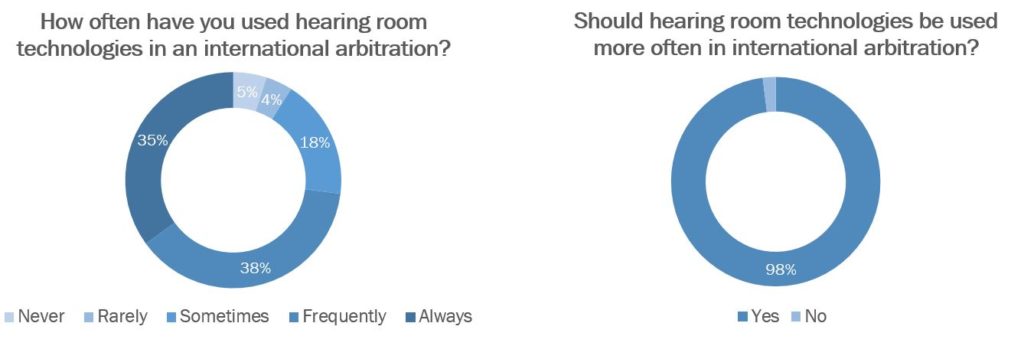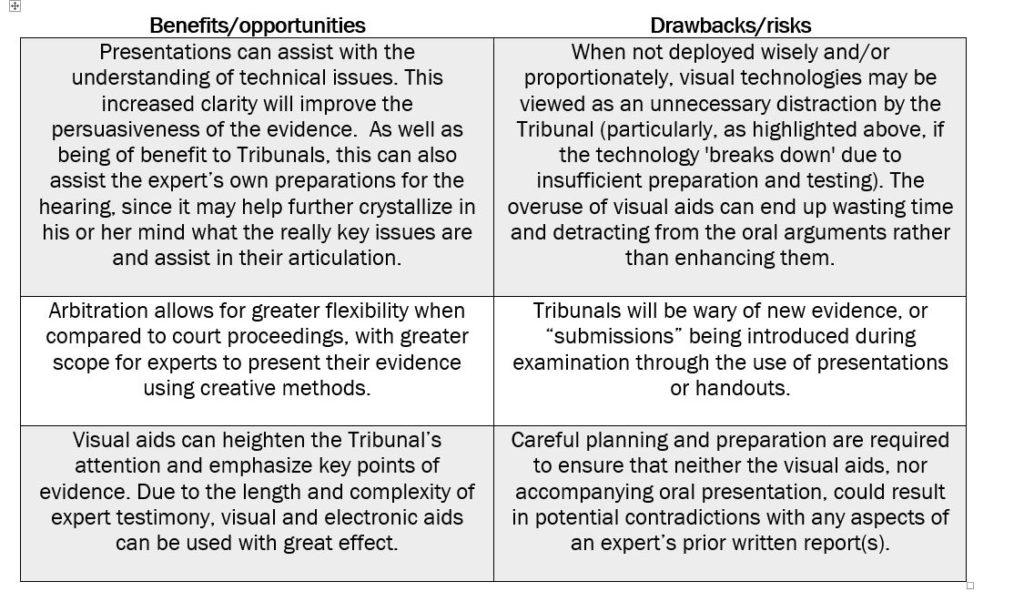In today’s busy and increasingly digitized world, pictures are the new words. The average human attention span has grown shorter and become more selective. In every facet of society, from the consumer landscape to business meetings, visual storytelling has emerged as key to delivering captivating content that commands a person’s undivided attention.
This trend can also be seen in the courtroom and in international arbitration where the use of visual aids and technology are on the rise. In fact, it is now becoming common for experts to deliver presentations to enhance the traditional, formulaic exchanges with counsel in international arbitration. For example, as shown in a 2018 International Arbitration Survey by Queen Mary University of London, 73% of respondents to the survey claimed to “always” or “frequently” use hearing room technologies (including multimedia presentations and real time electronic transcripts) in international arbitration, and almost all (98%) believed that arbitrators should make use of these tools more often.

(Source: 2018 International Arbitration Survey: The Evolution of International Arbitration, Queen Mary University of London, pages 32-33)
If a picture really is worth a thousand words, how can experts (and their counsel) present their often complex opinions in a clear, concise, and engaging way? This blog post will answer this question by explaining the use of presentations, as well as visual and electronic aids, from a quantum expert’s perspective based on practical experiences, and will discuss the benefits and drawbacks of their use in international arbitration.
Using visual aids in direct examination
International arbitration institutions such as the London Court of International Arbitration (LCIA) and International Chamber of Commerce (ICC) provide rules on expert evidence. However, there is limited guidance for how the examination of experts should be carried out, with broad discretion given to the Tribunal to determine how the testimony is conducted. For example, ICC guidance for experts states that “the tribunal will determine whether expert testimony will be allowed, … how long you will be permitted to testify, the limits of cross-examination, and so forth.”
Traditionally, the direct examination of an expert has been limited to a small number of procedural questions from counsel to introduce the expert and the key points from their written report. Increasingly, however, this approach is being replaced or supplemented by an oral presentation. This allows experts to explain in their own words the basis for reaching their opinions, to highlight the conclusions as set out in their report, and to address any areas of disagreement with opposing expert(s).
Since visual aids are more impactful with listeners and help with memory retention, it stands to reason that including visual content during direct examination of expert witnesses may help better engage the tribunal and ensure the expert’s opinion is more memorable. It is important to note that presentations may vary in length and format depending on the nature of the evidence, ranging from 10 minutes to over an hour in length, and may include visual and electronic aids, such as PowerPoint presentations, which could include charts, graphs, key points in summary written form, or even animation.
Walking the walk – practical experience utilizing visual aids
In our practice providing expert testimony, we have experienced several occasions where it has been beneficial to use one of the methods of examination outlined above. Recent examples include:
1. Delivering an oral presentation as part of direct examination;
2. Preparing PowerPoint slides to accompany oral presentation;
3. Using handouts or ‘demonstratives’, with copies provided to the Tribunal, alongside direct examination questions from counsel;
4. Preparing particular slides and visual aids for use at appropriate points in anticipation of subjects that are likely to arise in direct or cross-examination; and/or
5. Using hearing room technology to bring up exhibits in real-time during witness conferencing.
As a firsthand example, the use of visual aids and hearing room technology recently proved valuable during a witness conferencing session (colloquially known as “hot-tubbing,” an approach increasingly common in international arbitration whereby both experts are examined together). At one point during proceedings, an issue arose that could only be addressed by reference to detailed financial records. We were able to hand up to the tribunal visual representations of relevant key facts we had prepared in advance to support our view, and that helped to more clearly articulate the position. At another point, when challenged by our opposing expert, technology and an immediate visual display of a key document retrieved from the arbitration file enabled us to effectively rebut the relevant point (notably, our client won on these, and all other, points).
Guidance on the use of technology in arbitration
Given that good visual aids are persuasive and memorable and, thus, can be helpful in direct examinations of expert witnesses — what guidance for their use is available? Neither the LCIA or ICC rules of arbitration provide specific direction on the use of technology. However, the ICC published a Commission Report on Information Technology in International Arbitration in 2017, which encourages practitioners to consider how technology can be most effectively incorporated into proceedings. The report states that the Task Force “enthusiastically recommends the use of IT in international arbitration whenever appropriate,” while acknowledging that its use is a matter for the parties and the Tribunal to agree upon.
The report advises that each party is responsible for making arrangements regarding PowerPoint slides or other visual aids and must allow themselves sufficient time to prepare and test any technology before the hearing begins. While preparation and testing may appear a simple point, from our own recent attendance at a large-scale hearing where a key technology broke down on several occasions, there is an inherent associated risk when dealing with technology, which is important to keep in mind when deciding whether or not to use visual aids.
Benefits and risks of using presentations, visual, and electronic aids
Unreliable technology is not the only risk associated with using visual aids during international arbitration. In fact, there are a number of potentially significant drawbacks/risks, as well as benefits/opportunities, associated with using presentations, visuals, and electronic aids during expert testimony, including the following:

Key takeaways
Whilst visual engagement is key to communicating effectively, there is currently limited guidance available as to how visuals can or should be used by experts in international arbitration. In our experience, the heightened impact of bringing data to life in graphics or presentations is well worth the time diverted from focusing wholly on cross-examination. As set out above, the process of synthesizing and summarizing an expert’s views can help the preparation process and assist in the articulation of key points. Further, we believe the natural progression towards using visual and electronic aids to better articulate complex points of view in an easily digestible manner will only continue given the flexibility of international arbitration.
Ultimately, due consideration should be given to how best to use technology to achieve the desired effect and experts should discuss their plans carefully with counsel well in advance of the hearing. When used appropriately, visual and electronic aids can greatly increase the quality and persuasiveness of an expert’s testimony, which we have seen in practice and experienced first-hand in numerous international arbitrations.
Neil Ashton, a Partner with StoneTurn in London, acts as an expert witness, adviser and expert determiner in complex domestic and international litigation, arbitration and mediation.
Dan Langley, a Director with StoneTurn in London, has given evidence in complex commercial disputes before ICC Tribunals in Paris and a LCIA Tribunal in London.
Elizabeth Davidson, an Executive with StoneTurn in London, provides expertise in forensic accounting, financial crime advisory and external audit as part of complex business litigation and international arbitration.
________________________
To make sure you do not miss out on regular updates from the Kluwer Arbitration Blog, please subscribe here. To submit a proposal for a blog post, please consult our Editorial Guidelines.


